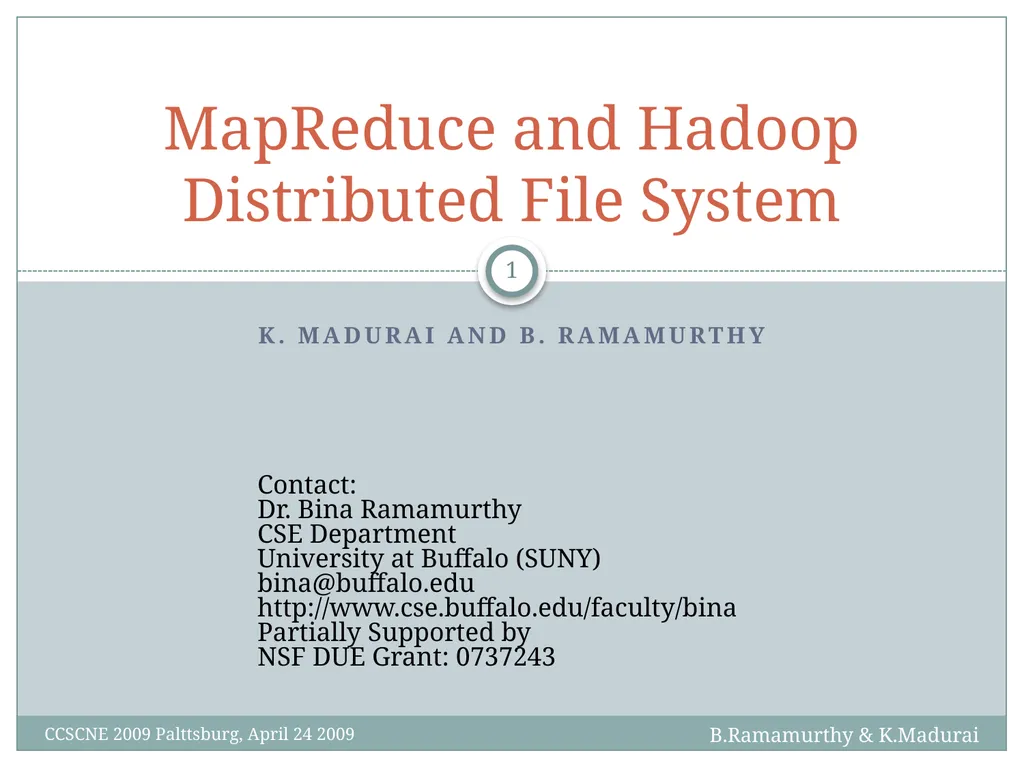K. Madurai and B. Ramamurthy MapReduce and Hadoop
Author : debby-jeon | Published Date : 2025-06-23
Description: K Madurai and B Ramamurthy MapReduce and Hadoop Distributed File System BRamamurthy KMadurai 1 Contact Dr Bina Ramamurthy CSE Department University at Buffalo SUNY binabuffaloedu httpwwwcsebuffaloedufacultybina Partially
Presentation Embed Code
Download Presentation
Download
Presentation The PPT/PDF document
"K. Madurai and B. Ramamurthy MapReduce and Hadoop" is the property of its rightful owner.
Permission is granted to download and print the materials on this website for personal, non-commercial use only,
and to display it on your personal computer provided you do not modify the materials and that you retain all
copyright notices contained in the materials. By downloading content from our website, you accept the terms of
this agreement.
Transcript:K. Madurai and B. Ramamurthy MapReduce and Hadoop:
K. Madurai and B. Ramamurthy MapReduce and Hadoop Distributed File System B.Ramamurthy & K.Madurai 1 Contact: Dr. Bina Ramamurthy CSE Department University at Buffalo (SUNY) bina@buffalo.edu http://www.cse.buffalo.edu/faculty/bina Partially Supported by NSF DUE Grant: 0737243 CCSCNE 2009 Palttsburg, April 24 2009 The Context: Big-data Man on the moon with 32KB (1969); my laptop had 2GB RAM (2009) Google collects 270PB data in a month (2007), 20000PB a day (2008) 2010 census data is expected to be a huge gold mine of information Data mining huge amounts of data collected in a wide range of domains from astronomy to healthcare has become essential for planning and performance. We are in a knowledge economy. Data is an important asset to any organization Discovery of knowledge; Enabling discovery; annotation of data We are looking at newer programming models, and Supporting algorithms and data structures. NSF refers to it as “data-intensive computing” and industry calls it “big-data” and “cloud computing” B.Ramamurthy & K.Madurai 2 CCSCNE 2009 Palttsburg, April 24 2009 Purpose of this talk To provide a simple introduction to: “The big-data computing” : An important advancement that has a potential to impact significantly the CS and undergraduate curriculum. A programming model called MapReduce for processing “big-data” A supporting file system called Hadoop Distributed File System (HDFS) To encourage educators to explore ways to infuse relevant concepts of this emerging area into their curriculum. B.Ramamurthy & K.Madurai 3 CCSCNE 2009 Palttsburg, April 24 2009 The Outline Introduction to MapReduce From CS Foundation to MapReduce MapReduce programming model Hadoop Distributed File System Relevance to Undergraduate Curriculum Demo (Internet access needed) Our experience with the framework Summary References B.Ramamurthy & K.Madurai 4 CCSCNE 2009 Palttsburg, April 24 2009 MapReduce CCSCNE 2009 Palttsburg, April 24 2009 B.Ramamurthy & K.Madurai 5 What is MapReduce? MapReduce is a programming model Google has used successfully is processing its “big-data” sets (~ 20000 peta bytes per day) Users specify the computation in terms of a map and a reduce function, Underlying runtime system automatically parallelizes the computation across large-scale clusters of machines, and Underlying system also handles machine failures, efficient communications, and performance issues. -- Reference: Dean, J. and Ghemawat, S. 2008. MapReduce: simplified data processing on large clusters. Communication of ACM 51, 1 (Jan. 2008), 107-113. B.Ramamurthy & K.Madurai 6 CCSCNE 2009 Palttsburg, April 24 2009 From CS Foundations to MapReduce Consider a large data collection: {web, weed, green, sun, moon,














